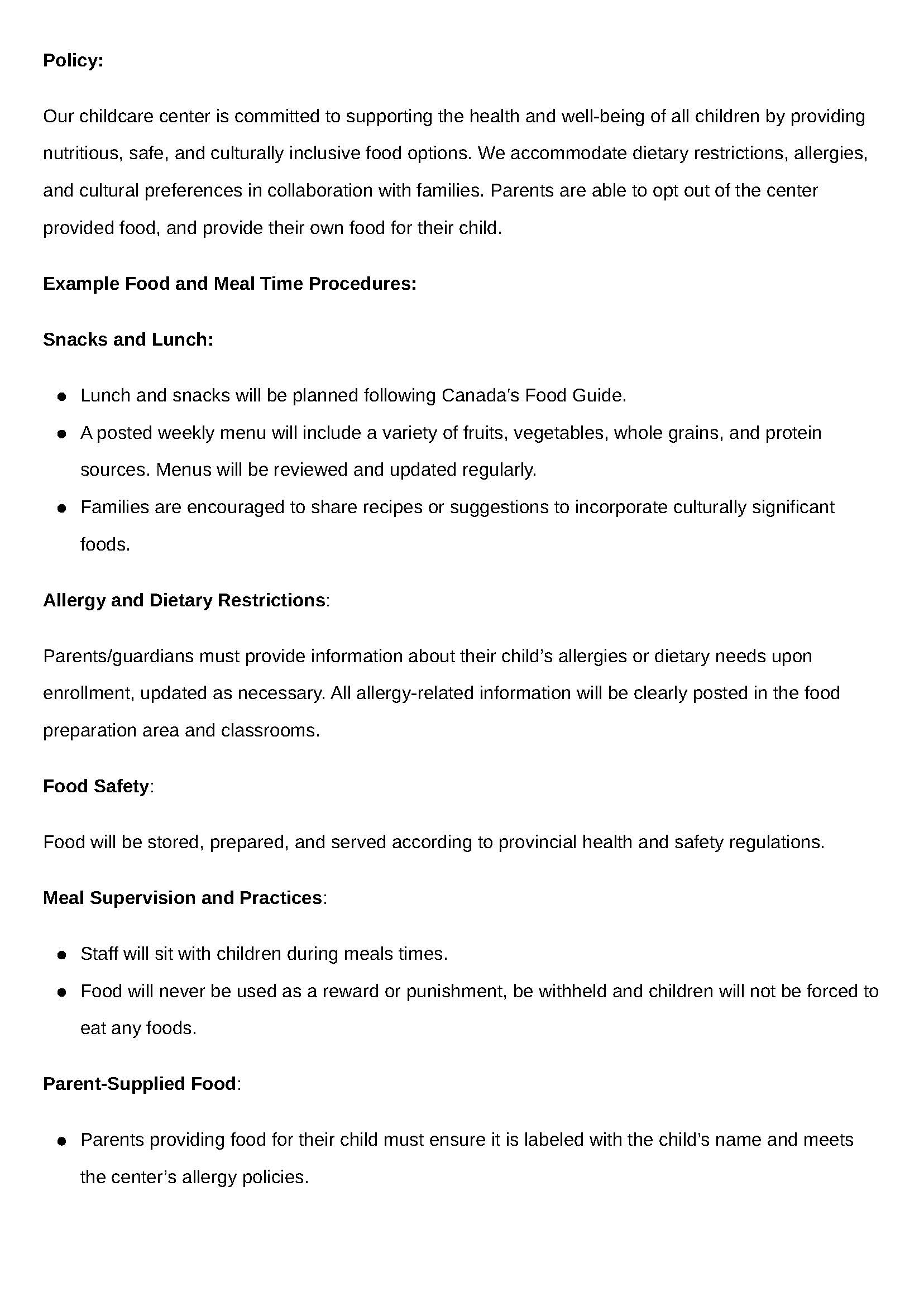Activity 3.3 | Writing Policies and Procedures
| Site: | RRU Open Educational Resources |
| Course: | Centre Management in Early Childcare and Education |
| Book: | Activity 3.3 | Writing Policies and Procedures |
| Printed by: | Guest user |
| Date: | Wednesday, 24 December 2025, 5:14 PM |
Creating policies and procedures
It is important to continue to revisit your vision, goals and philosophy when creating policies and procedures. What is important? What does that look like? How do we want to get there?
In this section, to provide an example of writing a policy we are going to explore creating a nutrition policy.
First, you need to start by outlining the key components you wish to include. Reflect on the considerations mentioned above and incorporate them into the policy. Some key points to address include:
What general nutritional guidelines will the centre follow (for example, Canada’s Food Guide, or the Healthy Food Guide for First Nation's Communities).
Will parents provide food, or will the centre supply it?
What role will families and staff play in shaping this policy?
How will the centre accommodate children with allergies, special dietary needs, or cultural or religious practices?
How frequently should meals and snacks be provided throughout the day?
What measures will be implemented to ensure food safety?
What specific licensing requirements must be adhered to?
Writing the Policy and procedure
Once you have gathered all the information needed and aligned that information with your centre's philosophy and vision, you will be prepared to write a policy! Here is an example policy about food and meal times:

First Nations Health Authority. (2014). Healthy food guidelines for First Nations communities (2nd ed.). https://www.fnha.ca/documents/healthy_food_guidelines_for_first_nations_communities.pdf
Health Canada. (2019). Canada's food guide. Government of Canada. https://food-guide.canada.ca/en/
Approaches to Food
Food plays a central role in ECE environments, influencing children’s well-being, development, and sense of belonging. Different childcare settings adopt various approaches based on funding, policies, and community values. While some programs require families to send meals from home, others provide food through funding initiatives such as Aboriginal Head Start or food programs.
Food practices in childcare settings are deeply influenced by funding availability, policy decisions, and community values. Whether through parent-provided meals, funded programs, or on-site preparation, these approaches impact children's nutrition, equity, and learning experiences. Recognizing food as a vital part of early learning ensures that all children have access to nourishing, inclusive, and community-centered meals.All children need to have food that meets their cultural, dietary and nutritional needs. Some childcare settings require families to pack their children's meals. This approach allows for parental choice and cultural preferences but can also introduce disparities in nutrition and food security. Children from food-insecure households may bring insufficient or low-nutrient meals, highlighting inequities. Other childcare centers receive funding or charge families to provide meals and snacks, ensuring consistent access to nutritious food. Programs like Aboriginal Head Start incorporate traditional and culturally relevant foods, reinforcing identity and belonging.
Food Policies and Beliefs
Beliefs about nutrition, equity, and community support shape food policies in childcare settings. Most programs follow the Canada or Indigenous dietary guides to promote balanced meals. Some policies may restrict certain foods, such as nuts, to protect children with allergies. On the other hand, programs may offer halal, vegetarian, or culturally specific meals to honor diverse backgrounds.
Beyond nutrition, food policies and practices in childcare settings help build relationships, teach social skills, and reinforce values of care and reciprocity. Shared meals can:
- Provide comfort and routine.
- Foster social interactions and turn mealtime into a learning experience.
- Strengthen family engagement through meal-sharing events or cooking activities.
Developing, Updating, or Evaluating a Centre’s Vision, Philosophy, and Policy/Procedure Documents
Now, you are asked to create a plan for developing, updating, or evaluating a childcare centre's vision, philosophy, and policy/procedure documents. Recognize that each context is unique, and different processes may apply depending on the specific needs and circumstances.
Practice Writing or Revising a Policy
Before you try to write or revise policy/procedures in your context make sure you practice! Try out drafting a new policy and procedure or select an existing one to rewrite with a more inclusive and relevant approach. Draw on the information and steps outlined in this course. When you have completed it reflect on how this process felt and what challenges you encountered. Share your revised policy with a colleague and gather feedback.
Go through the following questions in sequence:
- What are the steps you need to take to create or revise the documents?
- What is your timeline for completing this process?
- Are there specific policies in place for how policies and procedures are updated or changed?
- Who needs to approve the final documents?
- What is missing from the existing policies?
- What areas should be reevaluated to ensure alignment with current practices?
- Do these policies serve all members of the centre's community equally, or might they unintentionally disadvantage families or staff?
- Who are the staff, families, and even community members that should be consulted throughout the process?
- What are some ways you will gather their input and ensure it is reflected in the policy changes?
- Which legislation, regulations, and licensing requirements must be considered during the review and update process? Write a list of the relevant regulations.
- How will you create space for open discussions about the current policies?
- What is missing from this policy/procedure?
- Are there any parts that make you curious? Or that you had not considered before?
- How might these be different in a centre that provides all the food?